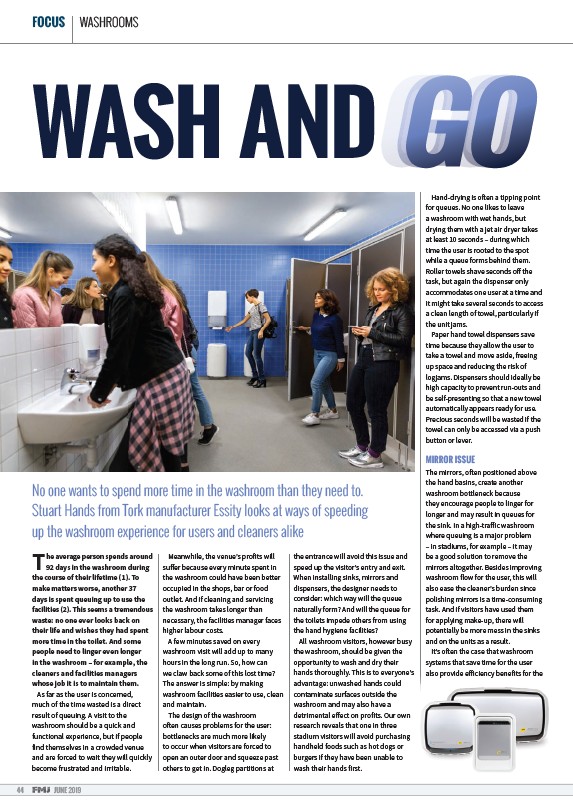
FOCUS WASHROOMS
WASH AND
No one wants to spend more time in the washroom than they need to.
Stuart Hands from Tork manufacturer Essity looks at ways of speeding
up the washroom experience for users and cleaners alike
The average person spends around
92 days in the washroom during
the course of their lifetime (1). To
make matters worse, another 37
days is spent queuing up to use the
facilities (2). This seems a tremendous
waste: no one ever looks back on
their life and wishes they had spent
more time in the toilet. And some
people need to linger even longer
in the washroom – for example, the
cleaners and facilities managers
whose job it is to maintain them.
As far as the user is concerned,
much of the time wasted is a direct
result of queuing. A visit to the
washroom should be a quick and
functional experience, but if people
find themselves in a crowded venue
and are forced to wait they will quickly
become frustrated and irritable.
44 JUNE 2019
Meanwhile, the venue’s profits will
su€ er because every minute spent in
the washroom could have been better
occupied in the shops, bar or food
outlet. And if cleaning and servicing
the washroom takes longer than
necessary, the facilities manager faces
higher labour costs.
A few minutes saved on every
washroom visit will add up to many
hours in the long run. So, how can
we claw back some of this lost time?
The answer is simple: by making
washroom facilities easier to use, clean
and maintain.
The design of the washroom
o‚ en causes problems for the user:
bottlenecks are much more likely
to occur when visitors are forced to
open an outer door and squeeze past
others to get in. Dogleg partitions at
the entrance will avoid this issue and
speed up the visitor’s entry and exit.
When installing sinks, mirrors and
dispensers, the designer needs to
consider: which way will the queue
naturally form? And will the queue for
the toilets impede others from using
the hand hygiene facilities?
All washroom visitors, however busy
the washroom, should be given the
opportunity to wash and dry their
hands thoroughly. This is to everyone’s
advantage: unwashed hands could
contaminate surfaces outside the
washroom and may also have a
detrimental e€ ect on profits. Our own
research reveals that one in three
stadium visitors will avoid purchasing
handheld foods such as hot dogs or
burgers if they have been unable to
wash their hands first.
Hand-drying is o‚ en a tipping point
for queues. No one likes to leave
a washroom with wet hands, but
drying them with a jet air dryer takes
at least 10 seconds – during which
time the user is rooted to the spot
while a queue forms behind them.
Roller towels shave seconds o€ the
task, but again the dispenser only
accommodates one user at a time and
it might take several seconds to access
a clean length of towel, particularly if
the unit jams.
Paper hand towel dispensers save
time because they allow the user to
take a towel and move aside, freeing
up space and reducing the risk of
logjams. Dispensers should ideally be
high capacity to prevent run-outs and
be self-presenting so that a new towel
automatically appears ready for use.
Precious seconds will be wasted if the
towel can only be accessed via a push
button or lever.
MIRROR ISSUE
The mirrors, o‚ en positioned above
the hand basins, create another
washroom bottleneck because
they encourage people to linger for
longer and may result in queues for
the sink. In a high-tra€ ic washroom
where queuing is a major problem
– in stadiums, for example – it may
be a good solution to remove the
mirrors altogether. Besides improving
washroom flow for the user, this will
also ease the cleaner’s burden since
polishing mirrors is a time-consuming
task. And if visitors have used them
for applying make-up, there will
potentially be more mess in the sinks
and on the units as a result.
It’s o‚ en the case that washroom
systems that save time for the user
also provide e€ iciency benefits for the